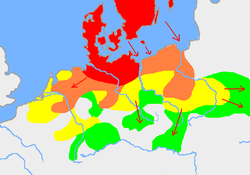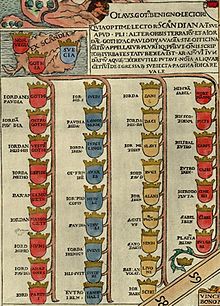The Goths (Gothic: 𐌲𐌿𐍄𐌸𐌹𐌿𐌳𐌰, romanized: Gutþiuda; Latin: Gothi, Greek: Γότθοι, translit. Gótthoi) were Germanic people who played a major role in the fall of the Western Roman Empire and the emergence of medieval Europe.[1][2][3]
In his book Getica (c. 551), the historian Jordanes writes that the Goths originated in southern Scandinavia, but the accuracy of this account is unclear.[1] A people called the Gutones – possibly early Goths – are documented living near the lower Vistula River in the 1st century, where they are associated with the archaeological Wielbark culture.[1][2] From the 2nd century, the Wielbark culture expanded southwards towards the Black Sea in what has been associated with Gothic migration, and by the late 3rd century it contributed to the formation of the Chernyakhov culture.[1][4] By the 4th century at the latest, several Gothic groups were distinguishable, among whom the Thervingi and Greuthungi were the most powerful.[5] During this time, Wulfila began the conversion of Goths to Christianity.[4]
In the late 4th century, the lands of the Goths were invaded from the east by the Huns. In the aftermath of this event, several groups of Goths came under Hunnic domination, while others migrated further west or sought refuge inside the Roman Empire. Goths who entered the Empire by crossing the Danube inflicted a devastating defeat upon the Romans at the Battle of Adrianople in 378. These Goths would form the Visigoths, and under their king Alaric I, they began a long migration, eventually establishing a Visigothic Kingdom in Spain at Toledo.[3] Meanwhile, Goths under Hunnic rule gained their independence in the 5th century, most importantly the Ostrogoths. Under their king Theodoric the Great, these Goths established an Ostrogothic Kingdom in Italy at Ravenna.[6][3]
The Ostrogothic Kingdom was destroyed by the Eastern Roman Empire in the 6th century, while the Visigothic Kingdom was conquered by the Umayyad Caliphate in the early 8th century. Remnants of Gothic communities in Crimea, known as the Crimean Goths, lingered on for several centuries, although Goths would eventually cease to exist as a distinct people.[5][4]
https://en.wikipedia.org/wiki/Goths
| Gothic | |
|---|---|
| Region | Oium, Dacia, Pannonia, Dalmatia, Italy, Gallia Narbonensis, Gallia Aquitania, Hispania, Crimea, North Caucasus |
| Era | attested 3rd–10th century; related dialects survived until 18th century in Crimea |
Indo-European
| |
| Dialects | |
| Gothic alphabet | |
| Language codes | |
| ISO 639-2 | got |
| ISO 639-3 | got |
| Glottolog | goth1244 |
| Linguasphere | 52-ADA |
Gothic is an extinct East Germanic language that was spoken by the Goths. It is known primarily from the Codex Argenteus, a 6th-century copy of a 4th-century Bible translation, and is the only East Germanic language with a sizeable text corpus. All others, including Burgundian and Vandalic, are known, if at all, only from proper names that survived in historical accounts, and from loanwords in other languages such as Portuguese, Spanish, Catalan, Occitan and French.
As a Germanic language, Gothic is a part of the Indo-European language family. It is the earliest Germanic language that is attested in any sizable texts, but it lacks any modern descendants. The oldest documents in Gothic date back to the fourth century. The language was in decline by the mid-sixth century, partly because of the military defeat of the Goths at the hands of the Franks, the elimination of the Goths in Italy, and geographic isolation (in Spain, the Gothic language lost its last and probably already declining function as a church language when the Visigoths converted from Arianism to Nicene Christianity in 589).[2] The language survived as a domestic language in the Iberian peninsula (modern-day Spain and Portugal) as late as the eighth century. Gothic-seeming terms are found in manuscripts subsequent to this date, but these may or may not belong to the same language. In particular, a language known as Crimean Gothic survived in the lower Danube area and in isolated mountain regions in Crimea as late as the second half of the 18th century. Lacking certain sound changes characteristic of Gothic, however, Crimean Gothic cannot be a lineal descendant of Bible Gothic.[3]
The existence of such early attested texts makes it a language of considerable interest in comparative linguistics.
https://en.wikipedia.org/wiki/Gothic_language
https://en.wikipedia.org/wiki/Gothic_Christianity
https://en.wikipedia.org/wiki/Troubadour_style
https://en.wikipedia.org/wiki/Scottish_baronial_architecture
https://en.wikipedia.org/wiki/Collegiate_Gothic
https://en.wikipedia.org/wiki/Carpenter_Gothic
https://en.wikipedia.org/wiki/Crimean_Gothic
https://en.wikipedia.org/wiki/Tech_noir
https://en.wikipedia.org/wiki/Suburban_Gothic
https://en.wikipedia.org/wiki/Urban_Gothic
https://en.wikipedia.org/wiki/Gothic_fiction
Gothicism or Gothism (Swedish: Göticism Swedish pronunciation: [ˈjøːtɪsˌɪsm]; Latin: Gothicismus) was a cultural movement in Sweden, centered on the belief in the glory of the Swedish Geats, who were identified with the Goths. The founders of the movement were Nicolaus Ragvaldi and the brothers Johannes and Olaus Magnus. The belief continued to hold power in the 17th century, when Sweden was a great power following the Thirty Years' War, but lost most of its sway in the 18th. It was renewed by the Viking revival and Romantic nationalism in the early 19th century, this time with the Vikings as heroic figures.
https://en.wikipedia.org/wiki/Gothicism
https://en.wikipedia.org/wiki/American_Gothic_fiction
https://en.wikipedia.org/wiki/Dissenting_Gothic
https://en.wikipedia.org/wiki/Category:Architectural_styles
https://en.wikipedia.org/wiki/High_Victorian_Gothic







No comments:
Post a Comment